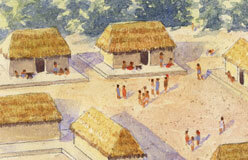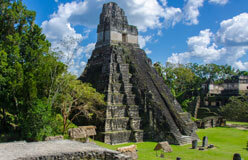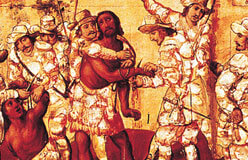Maya civilization flourished for many centuries. But then, from about A.D. 800 to 900, nearly all Maya cities in the southern lowlands were abandoned.
Many theories have been proposed to explain why this happened: conquering armies of Mexicans, climatic changes, earthquakes, epidemics, economic failure, social disintegration, overpopulation and starvation, or uprisings among the masses. It could have been a combination of all these factors. A good guess is that a combination of outside pressures and internal tensions led to the collapse of the Maya.
Although the southern lowlands were nearly deserted, Maya splendor did continue in the Yucatán peninsula. When Spanish explorers set foot there in the early part of the sixteenth century, they found cities thronged with people. They saw highly decorated palaces, temples raised on terraced pyramids, paved stone roads, and bustling marketplaces. They met leaders who wore jade and gold jewelry, intricate headdresses, jaguar-skin skirts, and brightly colored feathered capes. They also found warriors with bows, arrows, and clubs.
For years, the Spanish had been searching for the legendary El Dorado, where great riches were supposed to be found. The cities of the Maya could have been it. But the desire of the Spanish to convert others to their religion led ultimately to the destruction of the most brilliant civilization in pre-Columbian America.







